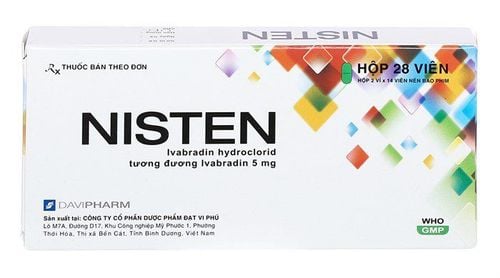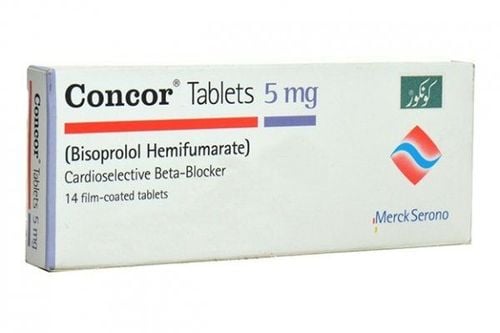This is an automatically translated article.
Atorvis is made in the form of tablets, the main ingredient is Atorvastatin. The drug is used to lower blood lipids and prevent cardiovascular disease.
1. What does Atorvis do?
1 Atorvis tablet contains 10mg of Atorvastatin (as atorvastatin calcium trihydrate) and other excipients. Atorvastatin is a selective, competitive inhibitor of HMG-CoA reductase, the enzyme that catalyzes the conversion of HMG-CoA to mevalonic acid, a precursor of cholesterol.
Statins inhibit HMG-CoA reductase, reduce cholesterol biosynthesis in hepatocytes, reduce cholesterol concentrations in cells. This leads to an increase in the LDL-cholesterol receptors on the hepatocyte membranes, which increases the clearance of LDL from the circulation. Statins will lower total cholesterol, VLDL-C, LDL-C, and triglycerides and increase plasma HDL-C.
In addition, statins also have anti-atherosclerotic effects, reducing blood pressure in patients with hypertension and primary hypercholesterolemia. It also has anti-inflammatory effects in patients with hypercholesterolemia, with/without coronary artery disease, possibly increasing bone density.
Atorvis is indicated in the following cases:
Prevention of cardiovascular disease:
For adults with no clinically apparent symptoms of coronary heart disease but with multiple risk factors for coronary heart disease such as smoking smoking, advanced age, high blood pressure, low HDL-C or a family history of early coronary artery disease, Atorvastatin is indicated to: Reduce the risk of myocardial infarction; Reduce the risk of stroke ; Reduced risk for revascularization and angina; In patients with type 2 diabetes and no obvious coronary heart disease but with multiple risk factors for the disease such as albuminuria, smoking, retinopathy, hypertension, etc., atorvastatin is indicated to: Reduce: risk of myocardial infarction; Reduce the risk of stroke; In patients with clinically evident coronary artery disease, Atorvastatin is indicated to: Reduce the risk of myocardial infarction (non-fatal); Reduced risk of fatal/non-fatal stroke; Reduced risk for revascularization; Reduce the risk of angina ; Reduces the risk of hospitalization for congestive heart failure. Lowering blood lipids:
Adjunct to diets to reduce total cholesterol (total C), LDL-C, apolipoprotein B and triglycerides, to help increase HDL-C in patients with primary hypercholesterolemia and people with mixed dyslipidemia; Adjunct to diet in the treatment of patients with hypertriglyceridemia; Treatment of patients with beta-lipoproteinemia who have not responded adequately to diet; As an adjunct to other lipid-lowering methods (such as LDL infusion) to lower total cholesterol and LDL-C in patients with homozygous familial hypercholesterolemia; As an adjunct to diet to reduce total cholesterol, apolipoprotein B, and LDL-C in menstruating boys and girls aged 10-17 years with heterozygous familial hypercholesterolaemia When using an appropriate diet, the patient still has characteristics such as: LDL-C level ≥ 190mg/dl or LDL-C level ≥160mg/dl and a family history of early cardiovascular disease or at least 2 other coronary heart disease risk factors. The use of Atorvis is contraindicated in the following cases:
Patients with hypersensitivity or allergy to active ingredients and components of the drug; Patients with advanced liver disease or persistent elevations of serum transaminases more than 3 times the upper limit of normal for unknown reasons; Pregnant women, lactating women, women of childbearing age who do not use appropriate contraception.
2. Usage and dosage of Atorvis
The drug is taken orally. Dosage of the drug is as follows:
Mixed dyslipidemia, hyperlipidemia: Treatment dose of Atorvastatin: 10 - 80mg/time/day; Recommended starting dose: 10mg/time/day or 20mg/time/day. If a significant reduction in LDL-C (more than 45%) is required, a dose of 40 mg/time/day may be initiated; The initial and maintenance doses of the drug depend on individual patient characteristics such as treatment goals and patient response. Should re-evaluate blood lipid levels after 2-4 weeks of drug treatment, adjust drug dosage accordingly if necessary; Can take a single dose a day at any time, when hungry or full. Hypercholesterolemia (heterozygous familial) in children 10 - 17 years old: Recommended starting dose: 10mg/time/day, maximum 20mg/day; Dosage should be individualized based on the goal of treatment. The dose can be adjusted every 4 weeks or over 4 weeks; Homozygous familial hypercholesterolemia: Dosage: 10 - 80mg/day. In these patients, Atorvastatin was used as an adjunct to other lipid-lowering therapies or when other therapies were unavailable; Combination with lipid-lowering methods: Atorvastatin can be administered with bile acid-binding resins. Caution should be exercised when combining HMG-CoA reductase inhibitors (statins) with fibrates; Patients with renal impairment: Renal disease does not affect the plasma concentration of Atorvastatin or the degree of LDL-C reduction of Atorvastatin, so no dose adjustment is required in this group of subjects; Patients taking clarithromycin, cyclosporin, itraconazole or protease inhibitors: Patients taking cyclosporin or HIV viral protease inhibitors or hepatitis C protease inhibitors should avoid Atorvastatin; In HIV patients receiving Lopinavir in combination with ritonavir, caution should be exercised when administering Atorvastatin, the lowest effective dose should be used; In patients taking clarithromycin, itraconazole, or HIV patients receiving darunavir plus ritonavir, fosamprenavir, saquinavir plus ritonavir, or fosamprenavir plus ritonavir, do not take Atorvastatin more than 20 mg/day, so clinical evaluation is recommended. appropriate screening to ensure that Atorvastatin is effective at the lowest dose; In patients receiving HIV protease inhibitor nelfinavir or hepatitis C protease inhibitor boceprevir should not exceed 40 mg/day of Atorvastatin, appropriate clinical judgment should be made to ensure the lowest possible dose of Atorvastatin is used. effective. There is currently no specific treatment for Atorvastatin overdose. If an overdose occurs, the patient should be treated symptomatically and take supportive measures when necessary. Liver function tests should be performed and serum CK levels monitored.
3. Side effects of Atorvis
When using Atorvis, patients may experience some side effects such as:
Common: Rhinitis - pharyngitis, allergic reactions, hyperglycemia, headache, sore throat - larynx, nosebleeds , nausea, diarrhea, flatulence, indigestion, constipation, joint pain, muscle pain, muscle spasms, joint swelling, back pain, abnormal liver function tests, elevated blood CK; Uncommon: Hypoglycaemia, anorexia, weight gain, insomnia, nightmares, decreased sensation, abnormal sensations, dizziness, dysgeusia, amnesia, tinnitus, blurred vision, vomiting, pancreatitis, upper and lower abdominal pain, belching, hepatitis, skin rash, urticaria, alopecia, skin pruritus, muscle fatigue, neck pain, malaise, chest pain, asthenia, fatigue, peripheral edema, fever, leukoplakia demand in the urine; Rare: Thrombocytopenia, peripheral neuropathy, cholestasis, visual disturbances, angioedema, bullous dermatitis, erythema multiforme, toxic epidermal necrolysis, Stevens-Johnson syndrome , fibromyalgia, acute rhabdomyolysis, myositis, tendinopathy, sometimes with complications of tendon rupture; Very rare: Hearing loss, anaphylaxis, liver failure, gynecomastia in men; Frequency unknown: Immune-mediated necrotizing myopathy. When experiencing side effects of Atorvis, patients should immediately notify their doctor to receive advice on the most effective intervention intervention.
4. Be careful when using Atorvis
Before and while taking Atorvis, patients should note:
Before treatment with statins, it is necessary to combine blood cholesterol control with measures including: Losing weight, changing diet, exercising, adjusting blood pressure. treat the causes of hyperlipidemia; It is recommended that lipid levels should be checked periodically, and the dose should be adjusted according to the patient's response to the drug. The goal of treatment is to reduce LDL-C, so it is necessary to base on LDL-C levels to initiate treatment and assess response to treatment. Only when LDL-C testing is not possible should total cholesterol be used to monitor treatment; Liver enzyme tests should be performed prior to initiation of treatment with Atorvis and where clinical indications require subsequent testing; Before treatment with statins, serum creatine kinase (CK) levels should be measured, especially in patients at high risk of skeletal muscle toxicity such as blacks, the elderly, and co-administration with statins. Myotoxic drugs, patients with hypothyroidism, impaired renal function, people with a personal or family history of hereditary myopathy, patients with a history of liver disease or heavy alcohol consumption, people with a history of myopathy due to previous statin or fibrate use. If CK test results are above 5 times the upper limit of normal, statin therapy should not be initiated; During statin treatment, patients should notify their doctor when they have muscle symptoms such as muscle stiffness, weakness, muscle pain, etc. When these symptoms are present, the patient should have a CK test. to take appropriate interventions; The risk of myopathy should be considered in patients on statin therapy who present with diffuse myalgia, muscle weakness, tenderness, or serum CK levels above 10 times the upper limit of normal. Stain therapy should be discontinued if serum CK levels are elevated or if disease is diagnosed/suspected. If a patient has myalgia without elevation or a moderate increase in serum CK (3-10 upper limit of normal), the patient should be monitored weekly until symptoms subside. If symptoms worsen, the drug must be discontinued; When Atorvis is used in combination with HIV and HCV protease inhibitors, drug interactions may occur, leading to an increased risk of muscle damage, most seriously rhabdomyolysis, kidney failure leading to renal failure, can be fatal, should be used with caution; Discontinue statins if patients present with acute and severe myopathy or risk factors for acute renal failure due to rhabdomyolysis, such as hypotension, severe acute infection, surgery, major trauma, any often endocrine - metabolic - electrolyte, uncontrolled seizures; Statin should be used in women of reproductive age only when they are definitely not pregnant and only in cases of very high blood cholesterol that has not responded to other medications; Before initiating treatment with Atorvastatin at 80 mg/day in patients with a history of hemorrhagic stroke or hemorrhagic stroke, the potential risk of hemorrhagic stroke should be weighed against the benefits of the drug; Certain types of statins, when treated for a long time, can cause interstitial lung disease. Symptoms include shortness of breath, dry cough, deterioration of health (weight loss, fever, fatigue). Statins should be discontinued if drug-induced interstitial lung disease is suspected; Some evidence points to statins as a blood glucose-raising agent. People at risk for diabetes may experience drug-induced hyperglycemia. Therefore, caution should be exercised when administering Atorvis in diabetics. However, the risk of hyperglycemia is lowered by the reduced risk of vascular disease with statins, so this is not a reason for diabetics to stop taking it; Atorvis can harm an unborn baby if taken by a pregnant woman. Therefore, this drug is contraindicated in pregnant women; Many statins are excreted in breast milk. Because of the potential for serious adverse effects in nursing infants, Atorvis is contraindicated in nursing women; Atorvis can cause dizziness, headache, blurred vision, ... should be used with caution when driving or operating machinery.
5. Atorvis drug interactions
Some Atorvis drug interactions include:
Strong inhibitors of CYP3A4 significantly increase plasma concentrations of Atorvastatin. Therefore, concomitant use of Atorvastatin with strong inhibitors of CYP3A4 such as telithromycin, cyclosporin, clarithromycin, stiripentol, delavirdin, ketoconazole, itraconazole, voriconazole, posaconazole and HIV protease inhibitors should be avoided. If co-administration of these drugs is required, a lower than usual starting and maximum dose of Atorvastatin should be used, and the patient should be monitored clinically; Moderate CYP3A4 inhibitors such as erythromycin, verapamil, diltiazem and fluconazole may increase plasma concentrations of Atorvastatin. Therefore, a lower than normal maximum dose of Atorvastatin should be considered, and the patient should be monitored clinically (after initiation of therapy or during dose adjustment of inhibitors); Concomitant use of Atorvastatin with inducers of CYP3A4 such as efavirenz, rifampin,... may slightly decrease the plasma concentration of Atorvastatin. Careful monitoring of the effectiveness of drugs when used concurrently is recommended; Transporter protein inhibitors such as cyclosporin may increase systemic exposure of Atorvastatin. If co-administration of the above drugs is required, the dose of Atorvastatin should be reduced and the clinical efficacy of the drug monitored; Concomitant use of fibric acid derivatives with Atorvastatin may increase the risk of muscle-related diseases, including acute rhabdomyolysis. If co-administration is required, the lowest possible dose of Atorvastatin should be used to achieve the therapeutic goal and the patient's manifestations should be closely monitored; Concomitant use of ezetimibe with Atorvastatin may increase the risk of muscle-related diseases, including acute rhabdomyolysis. Therefore, clinical monitoring of patients when these 2 drugs are used concurrently is recommended; When co-administered with colestipol, plasma concentrations of Atorvastatin and its metabolites are lower. However, the lipid-lowering effect when using these two drugs in combination is higher than when using each drug alone; Concomitant use of fusidic acid with Atorvastatin may increase the risk of myopathy, including acute rhabdomyolysis (in some cases fatal). If treatment with fusidic acid is required, consideration should be given to discontinuing Atorvastatin for the duration of the drug; Concomitant use of colchicine with Atorvastatin may increase the risk of myopathy. Therefore, caution should be exercised when these drugs are co-administered; Concomitant use of niacin with Atorvastatin may increase the risk of musculoskeletal diseases. Therefore, consideration should be given to reducing the dose of Atorvastatin when co-administered with niacin; When repeated doses of digoxin and atorvastatin 10 mg were administered concomitantly, steady-state digoxin concentrations were slightly increased. The health of patients taking digoxin with Atorvastatin should be monitored; Concomitant use of Atorvastatin with oral contraceptives may increase plasma concentrations of norethindrone and ethinyl estradiol; Concomitant administration of Atorvastatin 80 mg/day with warfarin may cause a slight decrease in prothrombin time of approximately 1.7 seconds during the first 4 days of treatment, which returns to normal within 15 days. The prothrombin time of patients on anticoagulants should be determined before initiating and periodically throughout the course of Atorvastatin. If the dose of Atorvastatin must be changed or discontinued, this examination should be repeated. Atorvastatin did not affect bleeding or change prothrombin time in patients not taking anticoagulants; Grapefruit juice contains one or more components that inhibit CYP3A4, thereby increasing the plasma concentration of Atorvastatin, especially when the patient drinks large amounts of grapefruit juice (over 1.2 liters/day). When prescribed to use Atorvis, patients should carefully read the instructions for use of the drug, follow the doctor's advice, combine with a suitable diet and activities to reduce blood lipids and prevent heart disease. efficient circuit.
Please dial HOTLINE for more information or register for an appointment HERE. Download MyVinmec app to make appointments faster and to manage your bookings easily.













